The Urban Tree Alliance (UTA) received funding from the WI DNR urban forestry grant program to develop the Housing Partnerships project. Continue reading “Urban Tree Alliance partners with Community Development Authority to complete tree inventory”
Another productive year for Wisconsin urban forestry!
Written by Jeff Roe, Urban Forestry Team Leader
As I reflect on this year, what stands out to me is cohesion and enthusiasm. Within the DNR, Division of Forestry, Urban Forestry Team and with our partners, I feel that communication, enthusiasm and follow-through have been hallmarks of this year.
Continue reading “Another productive year for Wisconsin urban forestry!”
2019 Urban forestry grant recipients announced
Thirty-eight communities, nonprofit groups, and counties will share over $532,000 in 2019 state grant dollars to promote and sustain urban forest resources in Wisconsin. Continue reading “2019 Urban forestry grant recipients announced”
Improve employee attitudes and well-being with exposure to trees and nature
The start of another weekday and we commute to work, only to be met by a dark cubicle or office covered in various shades of beige and grey. Ever wonder why your mood starts to match the walls? It’s because workplace environment contributes to employee health.
Continue reading “Improve employee attitudes and well-being with exposure to trees and nature”
Tree City USA applications are due
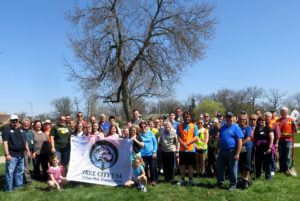 Trees make a town a special place to live. Trees shade homes, businesses and streets. They clean air and water, increase property values, reduce energy costs and make neighborhoods greener, safer and healthier. By becoming recognized and fulfilling the standards of Tree City, Tree Line, or Tree Campus USA, communities, companies and campuses are putting their citizens first and building a better community with the forest outside your door. Thousands of communities across America are enjoying these many benefits of trees and being recognized as a Tree City USA.
Trees make a town a special place to live. Trees shade homes, businesses and streets. They clean air and water, increase property values, reduce energy costs and make neighborhoods greener, safer and healthier. By becoming recognized and fulfilling the standards of Tree City, Tree Line, or Tree Campus USA, communities, companies and campuses are putting their citizens first and building a better community with the forest outside your door. Thousands of communities across America are enjoying these many benefits of trees and being recognized as a Tree City USA.
Markets growing for urban wood across Wisconsin
Written by Scott Lyon, Forest Products Specialist
Many communities have expressed greater interest in local goods and services over the last few years; as a result urban wood recycling efforts have increased in Wisconsin. The increase of trees killed by invasive insects and disease caused many municipalities to seek alternative uses for urban wood rather than disposing material in a landfill. Recent efforts to market this growing source of material and develop ways to recycle urban trees within communities led Wisconsin to become one of the leading states in urban wood utilization. Continue reading “Markets growing for urban wood across Wisconsin”
Accounting for trees in stormwater models
Accounting for Trees in Stormwater Models is a resource to share with stormwater engineers. The paper is intended to help the stormwater engineering community more easily account for trees in runoff and pollutant load calculations and incorporate them into stormwater management strategies. It summarizes existing hydrologic and hydraulic models that can be applied at the site and small watershed scales to account for the stormwater benefits of conserving existing trees and/or planting new trees. The paper also includes examples of specific techniques to modify stormwater models to account for urban tree benefits, as well as associated resources and tools for estimating the hydrologic benefits of trees in the urban landscape. Continue reading “Accounting for trees in stormwater models”
Does your community have forest-friendly development practices?
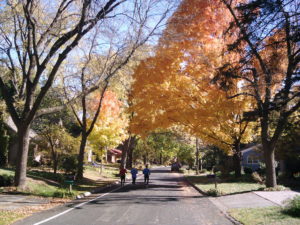 Not every city in Wisconsin has a municipal code or ordinance that includes trees, and even then, those that do have codes may not have forest-friendly ones. A new resource has been created and has taken care of the hard work of determining if your city’s codes are forest-friendly; and if they are not, the resource provides advice on how trees can be more welcome in your neighborhoods. Continue reading “Does your community have forest-friendly development practices?”
Not every city in Wisconsin has a municipal code or ordinance that includes trees, and even then, those that do have codes may not have forest-friendly ones. A new resource has been created and has taken care of the hard work of determining if your city’s codes are forest-friendly; and if they are not, the resource provides advice on how trees can be more welcome in your neighborhoods. Continue reading “Does your community have forest-friendly development practices?”
Trapping project found no non-native beetles
By Mike Hillstrom, forest health specialist, Fitchburg. Michael.Hillstrom@wisconsin.gov; 608-513-7690
The Wisconsin DNR’s forest health team received funding to trap for non-native beetles in 2018. This project was funded by the US Forest Service through an Early Detection and Rapid Response (EDRR) grant. The project is complete, and we happily share that we did not find any non-native beetles!
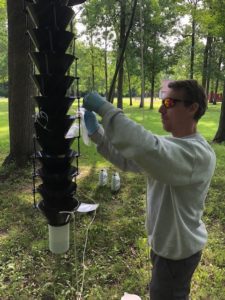
Forest health staff member Scott Schumacher hangs a Lindgren funnel trap to survey for non-native beetles.
The Forest Service periodically provides funding to states to trap for non-native bark and ambrosia beetles. The goal of trapping is to detect, delimit and monitor newly introduced exotic beetles and to quickly assess and respond to newly detected infestations.
We placed traps at 12 high-risk sites in Jefferson, Waukesha, Milwaukee, Racine, Manitowoc, and Brown counties. Sites were selected in collaboration with the Wisconsin Department of Agriculture, Trade and Consumer Protection and were based on proximity to large commercial port entries on Lake Michigan or recycling facilities for pallets and other waste packaging. Three Lindgren funnel traps (12 funnels stacked to look like a tree trunk) and lures were assembled at each site and checked every two weeks between early May and early August. Specimens collected from the traps were sent to a Forest Service taxonomist for identification.
New northern oak wilt detections
By Paul Cigan, forest health specialist, Hayward. Paul.Cigan@wisconsin.gov; 715-416-4920 and Linda Williams forest health specialist, Woodruff. Linda.Williams@wisconsin.gov; 920-360-0665
Oak wilt (OW) was confirmed for the first time in Bayfield and Douglas counties and in 16 new northern townships in 2018. The new OW infections occurred on a range of properties, including county, tribal, private, U.S. Forest Service and Board of Commissioners of Public Lands. Wisconsin Department of Natural Resources (DNR) forest health staff are working proactively with affected property managers and landowners to address these infections and prioritize disease prevention and detection in the future.

Oak wilt distribution map. Confirmed counties are displayed in red. Confirmed townships are displayed in pink 6-mile square blocks.
The greatest risk of overland transmission in northern Wisconsin is from April 15 to July 15, when fungal spores readily infect open wounds. Most of these new cases occurred during this time frame due to stem and branch damage. The primary causes of damage were roadside brush clearing, pruning, lot clearing and storm-caused branch breakage. Fungal spores may have come from diseased oak firewood and unprocessed wood recently transported into these areas.
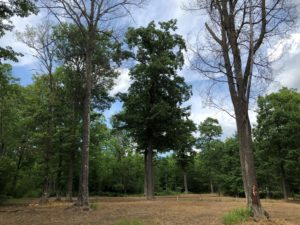
OW disease center. Oak on far left was infected through belowground root contact with tree damaged in lot clearing (far right). Dairyland Township, Douglas County (photo taken by Paul Cigan).
If oak wilt is present in or within 6 miles of the county where you manage oak, your management activities may be affected by seasonal harvesting restrictions to reduce OW introduction and impact. Read DNR’s oak harvesting guidelines for more information and refer to the list below of new 6 square mile blocks by township and county to see if OW has been detected near your property.
| Bayfield County | |
| Barnes | T45N R9W |
| Cable | T43N R7W |
| Drummond | T45N R8W |
| Douglas County | |
| Dairyland | T43N R15W |
| Gordon | T44N R11W |
| Langlade County | |
| Elcho | T34N R11E |
| Langlade | T33N R13E |
| Neva | T32N R11E |
| Sawyer County | |
| Couderay | T39N R8W |
| Hayward | T41N R8W |
| Hunter | T40N R7W |
| Round Lake | T41N R8W |
| Spider Lake | T42N R7W |
| Vilas County | |
| Boulder Junction | T42N R6E |
| Lac du Flambeau | T41N R5E, T40N R5E |
| St. Germain | T40N R8E |
Please report any suspected oak wilt infections to your local DNR forester or regional forest health specialist and learn more about oak wilt identification and biology on the DNR oak wilt webpage. To learn more about firewood rules and how you can help reduce transmission of pests and diseases, including oak wilt, visit the DNR firewood page.
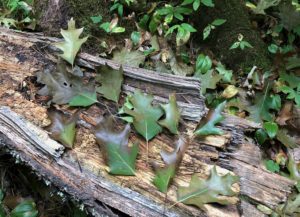
Bronzed leaves fallen from infected oak. Leaves were observed beneath infected northern red oak. Cable Township, Bayfield County (photo taken by Paul Cigan).
